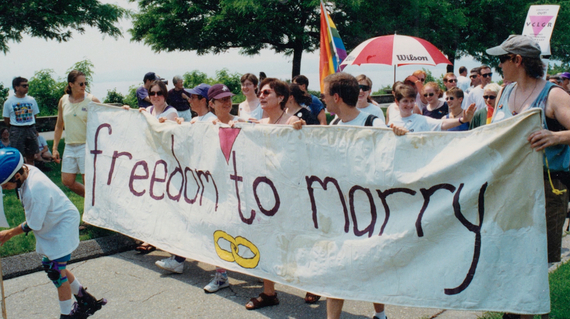Beth Robinson and Susan Murray were on my mind last spring as I prepared to argue the case for marriage equality before the U.S. Supreme Court. From a snowy drive to a meeting in Vermont to a steamy June day in D.C. when the Court announced its decision in Obergefell, I had travelled many miles and put in many hours with these two brilliant, brave, determined, and compassionate lawyers.
We met one December 1996 day at Beth's house to confirm plans about going forward with what some thought to be a crazy dream: securing marriage equality in Vermont. They had already been at work in building community and legislative support and the legal memos were thick even then. We agreed to team up and co-counsel in the first freedom to marry case since Hawaii. The national environment wasn't great: it was just six months after Congress had passed the federal Defense of Marriage Act, and states had started passing policies against "same-sex marriage." We thought Vermont was in a different place. For all of the angst on this issue, we saw only double standards, different treatment of same-sex couples, and no argument that could hold water against our constitutional claims. In July 1997, Beth and Susan at Langrock, Sperry & Wool and GLAD filed Baker v. State of Vermont. And the rest, as they say, is history.
The making of the documentary The State of Marriage enabled me to spend more time with Beth (now a justice on the Vermont Supreme Court) and Susan (still providing insightful and first rate legal services to her clients), enjoying their camaraderie, reviewing the building blocks and breakthroughs, and reflecting on the many roads that brought us to this moment. And of course we talked about how much work there is still to do!
The movie lifts up the human drama and painstaking work that social justice movements demand. For even before Baker was filed, Beth and Susan had been criss-crossing the state to help Vermonters get to know and understand their gay and lesbian neighbors. Long after the decision in Baker was announced in December 1999- granting full rights to same-sex couples but not the word "marriage" - Vermonters worked nearly another decade to achieve full marriage equality. The moment of its arrival was dramatic. In April 2009, the legislature overrode the governor's veto by one vote to become the first state in the nation to enact a marriage law, something our opponents vowed would never happen.
I cherish the time we spent preparing the legal arguments in Baker, both at the trial court and at the Vermont Supreme Court. It was a different era and we exchanged marked up copies of drafts by fax machine followed up by hours-long conference calls. Beth brilliantly carried the day at oral argument in the state high court in November 1998, with me and Susan at her side. I am very grateful for those experiences - not only for the friendships, but because the Vermont experience informed me and GLAD as we prepared to file Goodridge in Massachusetts and in all of our legislative and public education work on marriage and DOMA. We knew that winning in court would not be enough; we would have to win hearts and minds, and we would have to win at the statehouse as well.
In Vermont, I saw firsthand the power of keeping the focus on the people seeking to marry and their various stories. That case was very much about Stan Baker and Peter Harrigan, Lois Farnham and Holly Puterbaugh, and Nina Beck and Stacy Jolles, even as it was about all of us. All three couples lived in the greater Burlington area. Two of the three couples were parents. Their sharing the story of their love and their families allowed others to consider the fairness issues from our points of view. Nina and Stacy described how, for example, during their son Noah's birth, hospital agents had challenged Stacy's right to be there even with her documents in hand. Holly and Lois and Stan and Peter repeatedly shared their lives throughout the litigation. Tragically, early in the litigation, Noah's heart failed and a donor heart never came. After a period of grieving, Nina and Stacy returned, determined to make this a case for the benefit of all children of LGB parents. I am still amazed at their courage.
Exquisitely well told, The State of Marriage shows how pivotal Vermont was in getting us the freedom to marry. With thoughtful treatment of both sides, it is riveting, and full of drama.
The year since the Obergefell decision has been transformative. It has also been very hard. There's been tremendous pushback focused not just on marriage equality but on transgender people and attempts to put non-discrimination laws out of reach. Racial and economic disparities persist; LGBTQ youth are disproportionately homeless, and the high HIV rates among young black men are unacceptable. While the pushback is real, so is our knowledge of what we can do when we work together. Remember what we won last June 26! Let's use the tools we've acquired and the skills we've learned to keep moving forward, with all the urgency the moment demands.
--
Mary Bonauto is the Civil Rights Project Director for GLBTQ Legal Advocates & Defenders. THE STATE OF MARRIAGE is now available on iTunes and Digital Platforms.
